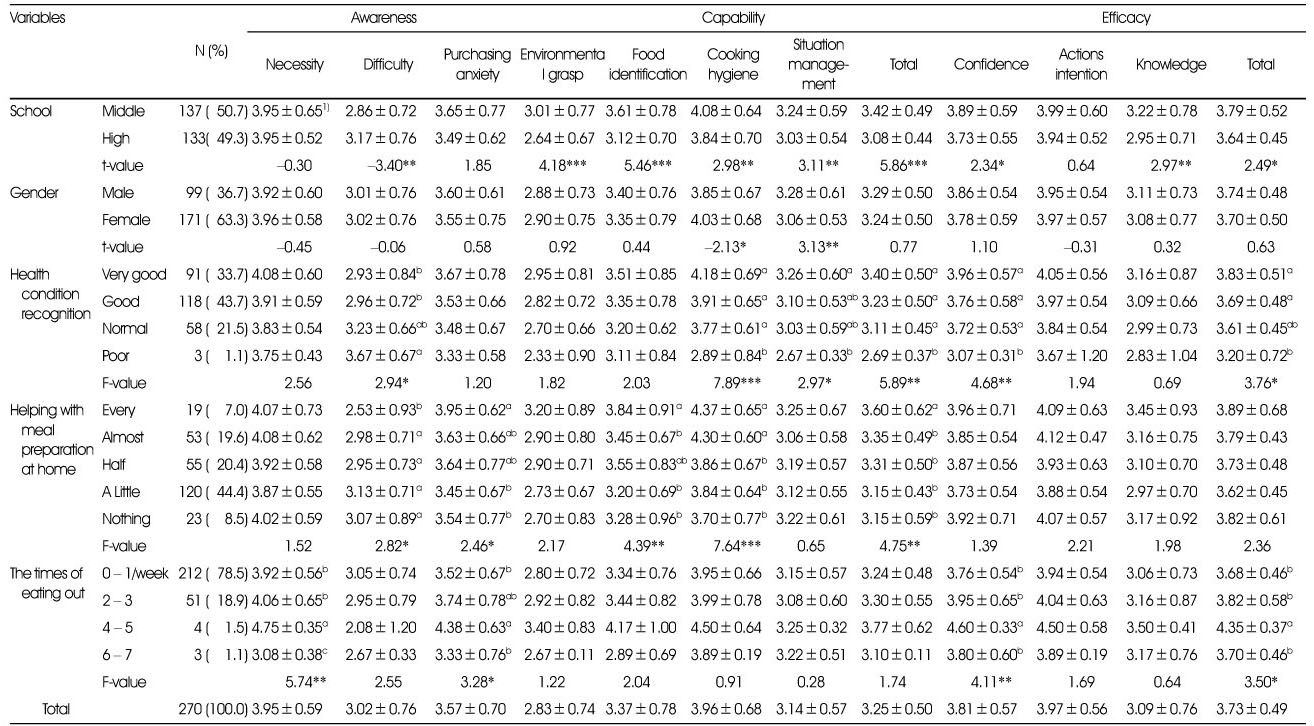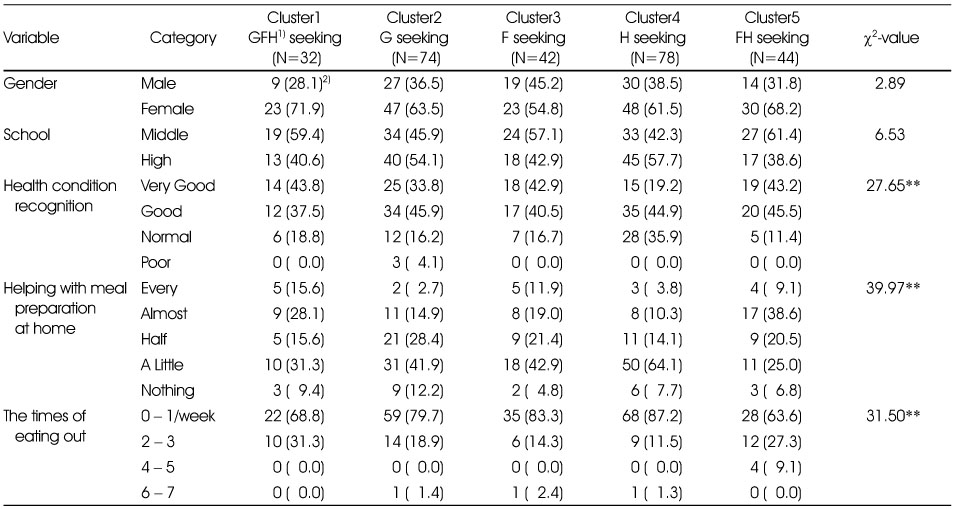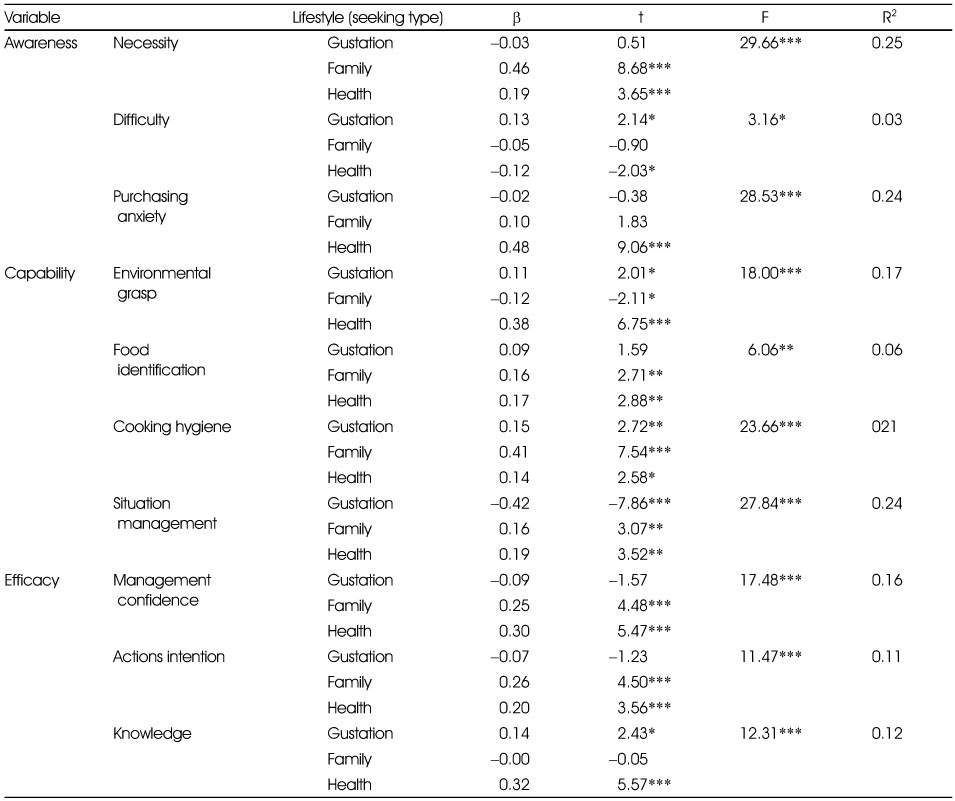Articles
- Page Path
- HOME > Korean J Community Nutr > Volume 21(6); 2016 > Article
-
Research Article
- Adulterated Food Management Characteristics according to Dietary Lifestyles among Adolescents
-
Yunhwa Kim

-
Korean Journal of Community Nutrition 2016;21(6):509-519.
DOI: https://doi.org/10.5720/kjcn.2016.21.6.509
Published online: December 31, 2016
Department of Family Welfare, Daegu University, Gyeongsan, Korea.
- Corresponding author: Yunhwa Kim. Department of Family Welfare, Daegu University, 201, Daegudae-ro, Jillyang-eup, Gyeongsan-si, Gyeongsangbuk-do, 38453, Korea. Tel: (053) 950-7193, Fax: (053) 850-6819, kyhwa47@gmail.com
Copyright © 2016 The Korean Society of Community Nutrition
This is an Open-Access article distributed under the terms of the Creative Commons Attribution Non-Commercial License (http://creativecommons.org/licenses/by-nc/3.0/) which permits unrestricted non-commercial use, distribution, and reproduction in any medium, provided the original work is properly cited.
- 709 Views
- 0 Download
- 5 Crossref
Abstract
-
Objectives
- Adulterated food education in adolescence period is very important because dietary management related to food safety is not made in a short period. This study aimed to identify dietary lifestyle factors which drive adulterated food management among middle and high school students.
-
Methods
- Data was collected from 270 middle and high school students in Daegu using a self-administered questionnaire in March and April of 2015. Data was analyzed using frequency analysis, one-way analysis of variance, χ2-test, factor analysis, reliability analysis, regression analysis, and cluster analysis.
-
Results
- The results of factor analysis indicated that adulterated food management awareness was classified into necessity, difficulty, and food purchasing anxiety. The adulterated food management capability was sub-grouped into environmental grasp, food identification, cooking hygiene, and situation management. The adulterated food management efficacy composed of management confidence, action intention, and knowledge. Dietary lifestyle comprised of gustation, family, and health factors after factor analysis, and it consisted of all seeking group, gustation seeking group, family seeking group, health seeking group, and family and health seeking group after cluster analysis. The gustation, family and health factors were significantly affected the factors of awareness, capability and efficacy of adulterated food management (p < 0.05). The frequency of health conditions, helping with meal preparation, and the times of eating out were significantly different according to seeking groups of dietary lifestyle (p < 0.01). The scores of awareness, capability and efficacy of adulterated food management of family and health seeking group were significantly higher than the other seeking groups (p < 0.05).
-
Conclusions
- This study suggests that adulterated food management education programs should account for gustation, family and health factors of dietary lifestyle to be effective for adolescents.
Acknowledgments
Acknowledgments
- 1. Jeon SK. Educational meanings and effective practical plans of school dietary life education. J Korean Home Econ Educ Assoc 2010; 22(1): 117-135.
- 2. Um EK. A study on the segmentation of food related lifestyle within Korean family. J Hotel Resort 2015; 14(3): 247-265.
- 3. Engel JF, Blackwell RD. Consumer behavior. 9th ed. NY: The Dryden Press; 2001.
- 4. Hong ST, Park EA. Comparison of female consumers' purchasing behavior by lifestyle types: In the case of cosmetics. Korea Mark Rev 2005; 20(1): 55-89.
- 5. Grunert KG, Perrea T, Zhou Y, Huang G, Sørensen BT. Is food-related lifestyle (FRL) able to reveal food consumption patterns in non-Western cultural environments? Its adaptation and application in urban China. Appetite 2011; 56(2): 357-367.ArticlePubMed
- 6. Chung W. Achievements and future tasks of the Korean police activities for harmful food elimination. J Korean Public Police Secur Stud 2016; 13(1): 233-256.Article
- 7. Korean National Police Agency. Promotion "Special enforcement junk food in the first half of 2016". 2016; cited 2016 Oct 8]. Available from: http://www.police.go.kr/portal/bbs/view.do?nttId=18376&bbsId=B0000011&menuNo=200067&delCode=0.
- 8. Ministry of Government Legislation. Bad food. 1st ed. Seoul: Humanculturearirang; 2015. p. 1-99.
- 9. Kim JH. Healthy life education for eradicating harmful food. Proceedings of 2013 Winter Conference of the Home Economics Education Association. Gwangju: 2013 Nov 05. p. 55-75.
- 10. Kim CK, Yoon BS, Kim HJ. The structure and dynamics of food risk society: Food security and food safe issues revisited. Econ Soc 2012; 96: 12-42.
- 11. Kim SU, Kim CK, Lee HJ. Socio-economic differentiation of food anxiety and food consumption behaviors. J Rural Soc 2012; 22(1): 215-264.
- 12. Park HS. The structural mechanism of food anxieties/scares and its emotional dynamics. Korean Stud Q 2010; 33(2): 161-193.
- 13. Yoo HJ, Joo SH. Development of consumers' perceived food safety and food safety competency measurement. J Consum Stud 2012; 23(4): 79-104.
- 14. Choe JS, Chun HK, Hwang DY, Nam HJ. Consumer perceptions of food-related hazards and correlates of degree of concerns about food. J Korean Soc Food Sci Nutr 2005; 34(1): 66-74.Article
- 15. Park NR, Sohn SH. The effects of food safety education on children's food safety knowledge, belief, attitude, and behavior. Consum Policy Educ Rev 2010; 6(1): 47-66.
- 16. Lee HS, Hwang SH. An effect of coffee shop customers' foodrelated lifestyle on coffee cocktail menu selection attributes and preference for menus. Tour Res 2014; 39(3): 141-159.
- 17. Golmakani N, Naghibi F, Moharari F, Esmaily H. Health promoting life style and its related factors in female adolescents. J Midwifery Reprod Health 2013; 1(1): 42-49.
- 18. Spratt J, Shucksmith J, Philip K, Watson C. Part of who we are as a school should include responsibility for well-being: links between the school environment, mental health and behavior. Pastor Care Educ 2006; 24(3): 14-21.
- 19. Sung CJ. A comparative study of food habits and body satisfaction of middle school students according to clinical symptoms. J Korean Soc Food Sci Nutr 2005; 34(2): 202-208.Article
- 20. Lee JS, Yun JW. A study on perception about body image, dietary attitude, dietary self-efficacy and nutrient intake of high school students in Busan. J Korean Soc Food Sci Nutr 2003; 32(2): 295-301.Article
- 21. Woo T, Lee HJ, Lee KA, Lee SM, Lee KH. Gender differences in adolescents' dietary perceptions and practices. Korean J Community Nutr 2016; 21(2): 165-177.ArticlePDF
- 22. Yoo SJ, Jung LH. A study on food involvement and dietary behavior of middle school students in Naju area. J Home Econ Educ Assoc 2008; 20(1): 63-83.
- 23. Grunert KG, Brunso K, Bisp S. Food-related life style: development of a cross-culturally valid instrument for market surveillance. MAPP working paper. 1993. p. 12.
- 24. Yim YM, Yoon HH. A study on the food-related life style to wine selection attribution. Korea Tour Res Assoc 2006; 20(3): 289-300.
- 25. Oh SC, Jang JS. The effects of food-related lifestyle on carbonated beverage consumption behavior of the middle school students. Korean J Food Nutr 2014; 27(6): 1043-1050.Article
- 26. Oh SC, Jang JS. The relationship of food-related lifestyle type and fast food consumption behaviors of the middle school students. Korean J Food Nutr 2015; 28(1): 119-125.Article
- 27. Jung YH, Kim HI, In KS. The impact of food consumption lifestyle on the comfort food and customer satisfaction. J Hotel Resort 2014; 13(2): 163-182.
- 28. Choi W, Choi JY, Yon HS. A study on purchasing characteristics on health functional beverage according to food-related lifestyle. J Hotel Resort 2013; 12(1): 179-196.
- 29. Kim HC, Kim MR. Intake behavior regarding beverages according to dietary lifestyles of university students. J East Asian Soc Dietary Life 2015; 25(2): 223-233.Article
- 30. Kim CK. The modern food system and food sovereignty. ECO 2008; 12(2): 7-32.
REFERENCES
Awareness, capabilities and efficacy of adulterated food management according to general characteristics of the study participants

Correlation of seeking type and awareness, capabilities and efficacy of adulterated food management

General and dietary characteristics of the study participants according to dietary lifestyles

Figure & Data
REFERENCES
Citations

- Study on the Eating Out Behavior and the Status of Meal Delivery and Take-Out Consumption according to the Food-related Lifestyles of Adolescents : Using the Consumption Behavior Survey for Food in 2020
Eun Jung Lee, Hyeon Min Yang, Yeong Ju Lee, Sun A Choi, Jeong Ok Rho
Journal of the East Asian Society of Dietary Life.2024; 34(4): 284. CrossRef - Dietary safety management competency for the sustainable health management of adolescents
Yunhwa Kim
Journal of Nutrition and Health.2022; 55(3): 406. CrossRef - Restaurant Meal Delivery and Take-Out Consumption Behavior according to Adolescents’ Food-Related Lifestyles
Yulee Shin, Minsook Kyung, Seonyeong Baek, Sunny Ham
Journal of the East Asian Society of Dietary Life.2021; 31(3): 172. CrossRef - Predicting adolescents’ behavioural intentions in adulterated food management
Yunhwa Kim
British Food Journal.2019; 122(1): 258. CrossRef - Survey on Foodservice Satisfaction and Dietary Education needs for Improvement of School Foodservice in Middle School Students in Seoul
Kyung-Hee Shin, Youngmee Lee, Wookyoun Cho
Korean Journal of Community Nutrition.2017; 22(2): 127. CrossRef
Awareness, capabilities and efficacy of adulterated food management according to general characteristics of the study participants
1) Mean±SD, Rated with a 5-point Likert scale 1=never, 5=highly.
*: p < 0.05, **: p < 0.01, ***: p < 0.001
abc: means in the same column with different superscripts are significantly different by the result of Duncan's multiple range test.
Correlation of seeking type and awareness, capabilities and efficacy of adulterated food management
*: p < 0.05, **: p < 0.01, ***: p < 0.001
Effect of lifestyle on adulterated food management
*: p < 0.05, **: p < 0.01, ***: p < 0.001
General and dietary characteristics of the study participants according to dietary lifestyles
1) Gustation (G), Family (F), Health (H)
2) N (%)
**: p < 0.01
Adulterated food management of the study participants according to dietary lifestyle group
1) Gustation (G), Family (F), Health (H)
2) Mean±SD, Rated with a 5-point Likert scale 1=never, 5=highly.
*: p < 0.05, ***: p < 0.001
abcd: means in the same with different superscripts are significantly different by the result of Duncan's multiple range test.
1) Mean±SD, Rated with a 5-point Likert scale 1=never, 5=highly. *: p < 0.05, **: p < 0.01, ***: p < 0.001 abc: means in the same column with different superscripts are significantly different by the result of Duncan's multiple range test.
*: p < 0.05, **: p < 0.01, ***: p < 0.001
*: p < 0.05, **: p < 0.01, ***: p < 0.001
1) Gustation (G), Family (F), Health (H) 2) N (%) **: p < 0.01
1) Gustation (G), Family (F), Health (H) 2) Mean±SD, Rated with a 5-point Likert scale 1=never, 5=highly. *: p < 0.05, ***: p < 0.001 abcd: means in the same with different superscripts are significantly different by the result of Duncan's multiple range test.

 KSCN
KSCN


 PubReader
PubReader Cite
Cite


